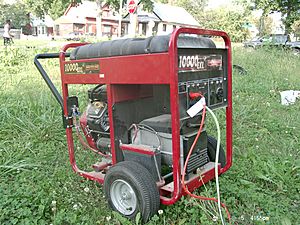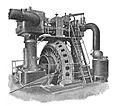Electrical generator facts for kids
A generator is a machine that creates electrical energy. It has a special part called a generator head, which contains wires. These wires spin inside a magnetic field. When they spin, it causes something called electromagnetic induction. This process makes electricity flow through the wires. Some hybrid electric vehicles have a powerful generator to help them run. The largest generators are found in big buildings called power stations, where they produce electricity for many homes and businesses.
Many different things can make a generator's head spin. Small generators might be turned by someone's arms or legs, like on a hand-crank radio. Bigger ones are connected to an engine. The very biggest generators use a steam turbine or the power of moving water, which is called hydroelectric power. Some generators even use wind power from wind turbines. No matter what makes it turn, the generator changes this turning energy into electrical energy.
Some portable generators have an internal combustion engine, similar to a car engine. It's very important to use these generators outdoors. They produce a dangerous gas called carbon monoxide, which you can't see or smell. Using them indoors can be very harmful.
Contents
How Generators Make Electricity
Generators work by using the connection between movement and magnetism to create electricity. When wires move through a magnetic field, it pushes the tiny particles that carry electricity (called electrons) to move. This movement of electrons is what we call electric current.
Turning Energy into Power
The main job of a generator is to convert one type of energy into electrical energy. For example, a wind turbine changes the energy of the wind into electricity. A hydroelectric dam uses the energy of falling water. In every case, the generator is the key part that makes the electricity.
Parts of a Generator
Even simple generators have a few main parts that work together to create electricity.
Key Components
- Rotor: This is the part of the generator that spins. It's the moving piece.
- Axle: The rotor is attached to an axle, which is like a central rod that helps it turn smoothly.
- Magnet: Generators need a magnet to create the magnetic field. The wires spin within this field.
- Brushes: These are small parts that help collect the electricity from the spinning wires and send it out to where it's needed.
Other Important Parts
Some generators might also have:
- Commutator: This is a special switch that helps control the direction of the electric current.
- Power Supply: Some generators need a small amount of electricity to get started. This power supply helps kick-start the process.
Related Pages
Images for kids
-
U.S. NRC image of a modern steam turbine generator (STG).
-
Early Ganz Generator in Zwevegem, West Flanders, Belgium
-
The Faraday disk was the first electric generator. The horseshoe-shaped magnet (A) created a magnetic field through the disk (D). When the disk was turned, this induced an electric current radially outward from the center toward the rim. The current flowed out through the sliding spring contact m, through the external circuit, and back into the center of the disk through the axle.
-
Ferranti alternating current generator, c. 1900.
-
The Athlone Power Station in Cape Town, South Africa
-
Hydroelectric power station at Gabčíkovo Dam, Slovakia
-
Hydroelectric power station at Glen Canyon Dam, Page, Arizona
-
Protesters at Occupy Wall Street using bicycles connected to a motor and one-way diode to charge batteries for their electronics
See also
 In Spanish: Generador eléctrico para niños
In Spanish: Generador eléctrico para niños














